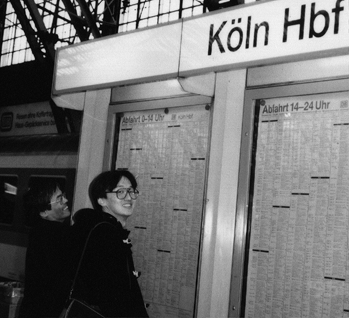
I visited the four research institutes identified above to investigate the progress of the work they are conducting and to discuss their future approach.
There are two types of activities being conducted by foreign research organizations for RWC Partnership. One involves the research work being conducted in close cooperation with the TRC, and the other involves the research work being conducted autonomously based on novel ideas.
Of the four institutions I visited, RISC-Linz of Austria and IRST of Italy are engaged in the second type of work. These two institutions are engaged in basic research relating to robots, and they are nearing the point where they will go from conceptual work to demonstrative work.
The relationship between the work being conducted at these two institutions and the other laboratories within RWCP is becoming apparent, and I obtained the impression that coordination with other RWCP laboratories will become very important in the near future.
Accordingly, I informed the management of these institutions that RWCP will conduct an interim review of the project with the aim of clarifying the plans for the second half of the project. I further informed them of our basic approach to the RWC research and that the review will start in fiscal 1995 for completion during fiscal 1996, involving combining and cancellation of some research themes. I stated that the key points in making these decisions are the relationships with the work being conducted by various laboratories and, if the work is conceptual in nature, the position the work occupies within the general framework of the RWC research. In conclusion, I requested the management to pay special attention to these points in their future operations.
During the discussions, I had the oppoitunity to tour the laboratories at these institutions. The laboratories are housed in buildings that are as modern as the TRC building, and the laboratories are equipped with advanced equipment. Because of their close ties to universities, the laboratories are frequently visited by rnany young scientists and I gained the impression that active discussions are held on a routine basis. In comparison, the headquarters and the staff cafeteria of the RISC-Linz are housed in a medieval castle-like building (I was told that it never was a castle). However, the interior is very modern including the equipment, and I was impressed with the European spirit that values preservation of the aesthetic assets of cities. I was fortunate to experience personally the cultural difference from the Japanese way which is to repeat construction and demolition.
Except for a handful of laboratories, all facilities are located in the suburbs of medium sized cities.
Especially, Italy's IRST is located in the city of Trento at the foot of Alps, and the view of the mountains surrounding this city was perfect for the word beautiful. Because Trento is close to Innsbruck, Austria, it is a major resort town for the skiers in the winter and vacationers in the summer from Germany.
I am looking forward to seeing the results from these European research institutions that have evolved in cultures that are significantly different from the Japanese culture.
